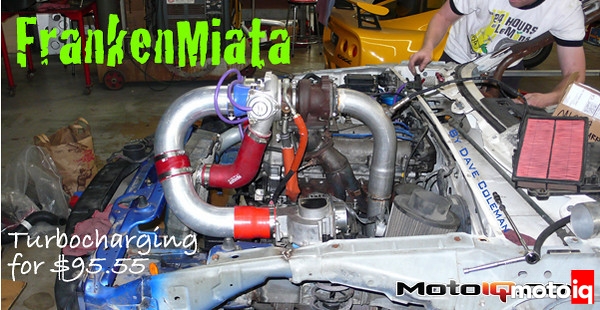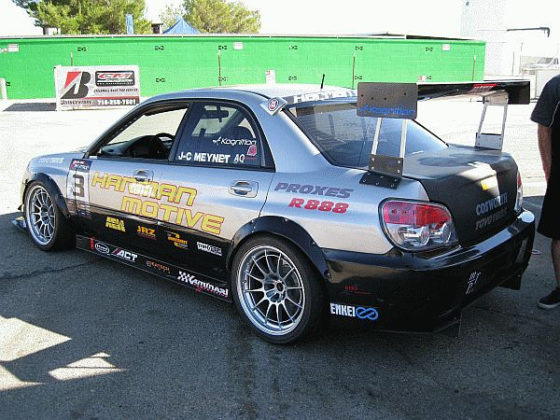
FrankenMiata – Turbocharging for $95.55
By Dave Coleman
We didn't need power. We proved that to ourselves by leading more than 6 hours of a LeMons race with our 77 hp CRX (RIP). Nimbleness, strategy, and aggressive driving were all we really needed. Until Mark DiBella reached under his workbench, dusted off a rusty old turbo, and asked, “do you think you guys could use this? It's from that old Mexican Dodge engine.”
 |
|
| Years of sitting in the rain had not been kind to our turbo. |
Ok, power might be good too…
“That old Mexican Dodge engine” requires some explanation. Jackson Racing was, for much of the '80s and early '90s, a leading Honda race shop. During that time Mark DiBella was Jackson's crew chief. In the late '90s, Jackson Racing evolved into an aftermarket tuner specializing in supercharger kits for Miatas, Hondas, and at one point, PT Cruisers.
Eager to have a healthy aftermarket for their new retro box, Dodge tried to help Jackson tackle the nascent PT Cruiser market by sending them a couple of engines from the Mexican market Dodge Stratus RT turbo. Mexican Dodges were turbocharged not to make them fast, but in an effort to maintain their adequacy in the thin air of Mexico City, a substantial burg of 10,000,000 people all living more than a mile above sea level.
 |
|
| Even after a thorough cleaning, our turbine housing was permanently pitted. This might explain some of the strange noises our turbo makes. |
The engine, kind gesture that it was, turned out to be no help at all, so it sat outside the dyno bay and rusted. Eventually Oscar Jackson retired to Colorado, Mark took over the shop, re-named it MD Automotive, and got tired of tripping over the rusty, old, brand-new, 0-mile engine. Before tossing it in the scrap metal bin, though, he unbolted the turbo and threw it under a workbench. You never know when a turbo might come in handy…
Up until this point, our argument against turbocharged LeMons cars had been simple. Turbo cars are harder to keep from overheating, they go fast enough to wear out their tires and brakes, they burn through gas faster, and there are a lot more ways to break them. In an endurance race, fuel strategy is key. If the turbo caused enough extra fuel consumption to cause one extra fuel stop, that would mean at least another 10 minutes off the track. Unless the turbo gained us 10 full minutes of speed, it wouldn't be worth it.
 |
|
The Mexican Stratus RT used a surprisingly small Mitsubishi TD04 turbo, considering the 2.4-liter engine it was bolted to. Dodge cranked 215 hp from this turbo. Volvo used exactly the same turbo on their S40 1.9T and managed only 160 hp. We planned to make even less. Note the diaphragm on the left side, which is the integral blow-off valve. The large one on the right is the wastegate actuator. Based solely on its large size, we assumed the wastegate was naturally set to open at relatively low boost. We guessed right. |
But it wasn't fuel stops that killed our 77-hp victory bid, it was crash damage. Going that fast with that little power meant driving like complete assholes, and you can only do that for so long before you puncture the radiator, bend the suspension, rip off the front bumper and fold up the frame rail until its rubbing on the alternator.
More power would let us drive less aggressively, pass at will in safe spots instead of taking chances and generally make fewer enemies.
Yeah, we'll say anything to justify a turbo.
Just slapping any old free turbo on your engine is a bad idea. You need a turbo that's at least close to the right size for your engine and your power goals. If you have three turbo engineers on your team, they can look at the part numbers on your Mexican Dodge turbo and figure out that it also was used on first-generation Volvo S40s. They can dig up maps, talk about mass flow rates, and make the rest of the team believe it's all gonna work out.
If you don't have any turbo engineers, figure out how much power the turbo made on its original application (215 hp in the Mexican Stratus, 160 hp in the Volvo). If this is in the ballpark of what you want to make, it'll probably be OK. If you only want to make half what the donor car made, expect some lag.
Free turbo manifold!
 |
|
| The outer four bolts are symmetrical, letting line up the manifold gasket on those four holes, mark where a few new holes needed to be, and get to cutting. |
Once you have a $97 engine and a free turbo, the biggest challenge is the exhaust manifold. Even the cheapest, weld-it-yourself log manifolds would eat up half a LeMons budget, leaving us not nearly enough cash to finish the car. No, we'd have to use what we already had. It turns out four of the holes on a 1.6 Miata manifold flange are symmetrical, and the rest are easily persuaded. That means the manifold can be mounted upside-down, (details in the captions) leaving us only with the question of how to bolt the turbo to the end of the Miata manifold.
 |
|
| With just a few notches cut in the edge of the flange, the bottom (now the top) of the manifold flange could be well secured. The top (now the bottom), though, had big gaps in the flange right where the manifold studs were. We solved this problem by bolting a thick steel bar across all four bottom studs, letting the bar put the clamping load on the flange. To stiffen the long span in the middle of the bar, we welded a rib to the middle of it. Not only is this stronger in the appropriate direction, the welding warped the bar so the ends pulled away from the flange. Bolding those ends down put even more clamping load in the middle of the bar. This arrangement has been rock solid. | |
 |
Although it would be simpler and more compact to simply cut the Miata downpipe flange off and weld on a turbo flange, we were paranoid about the stock manifold cracking (three of ours were already cracked, and they weren't dealing with turbo exhaust temps). Instead, we made an adaptor pipe, welding together a Miata downpipe flange, a few inches of stainless pipe cut out of a scrap stock RX-8 exhaust, and a Mitsubishi turbo flange from Road/Race Engineering. This way, the manifold stayed completely stock (except for the extra holes drilled in the flange) and when our manifold cracked, we could swap in one of our four spare manifolds and keep going.
Now, hanging the weight of a turbo on any exhaust manifold is a bad idea, but it's especially bad if it's a lightweight tubular manifold and the turbo is a long way from the engine (giving it a lot of leverage). To minimize stress on the manifold, we fabricated an elaborate support bracket to hold the weight of the turbo.
Another brace (concocted from a parking cable bracket and a hood hinge) connects the downpipe to one of the bellhousing bolts, preventing the swinging of the exhaust system from trying to yank the turbo off the manifold. Isolating the turbo from all these mechanical forces is critical to durability.
 |
 |
| It would be foolish to rely on the manifold to support the weight of the turbo, resist its inertia in hard cornering and constrain whatever horrific vibrations we might have designed into this structure. Instead, we built an elaborate support bracket to do all those things. Two brackets bolted to the driver's side of the head support the weight of the turbo. | The diagonal brace bolted to the passenger's side of the head, resists cornering loads and side-to-side modes of vibration. |



